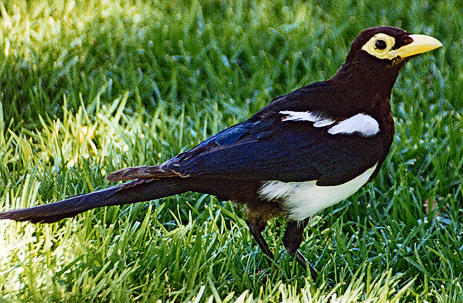The following essay was written by William B. Monahan, Senior GIS Scientist with Audubon California.
 The Yellow-billed Magpie’s native habitat in California is threatened by climate change.Alison Sheehey / California Audubon SocietyThey traipse through forest, grass and wetland, through mud, rain and even snow. They carry binoculars and take careful notes of everything they see.
The Yellow-billed Magpie’s native habitat in California is threatened by climate change.Alison Sheehey / California Audubon SocietyThey traipse through forest, grass and wetland, through mud, rain and even snow. They carry binoculars and take careful notes of everything they see.
These are the folks — thousands of dedicated bird watchers — that for more than 100 years have been taking part in the Audubon Christmas Bird Count, documenting fluctuations in bird populations the old-fashioned way: counting birds one by one, year after year.
Old fashioned as it is, this data has proven invaluable for researchers through several generations. Now, we at Audubon California have found a way to use the work of these volunteers to shed new light on climate change, one of the most challenging issues for bird conservation today.
For years, people have made substantial investments in conservation — billions and billions of dollars — with their fingers crossed that their work won’t simply be erased by climate change in the coming decades. If we’re going to ensure a future for birds and habitats, then we need to understand the changes that are coming.
Modern science provides a number of tools that enable us to create viable models of the potential future impacts of climate change on the environment. However, sophisticated GIS mapping and climate data are even more useful when we have historical information to both generate and test complex models.
Enter all those birders standing in the rain diligently counting Sandhill Cranes, Wilson’s Warblers and hundreds of other bird species in California and across the United States.
The history of scientific discovery is generally one of newer technology and methods replacing old ones: the telescope replacing the naked eye, the transistor replacing the vacuum tube, etc.
But this new work in the area of climate change is different. Once we combine these two technologies — the decidely low-tech counting of birds and the high-tech computer modeling and mapping — we make some surprising discoveries that wouldn’t have been possible with either on their own.
Perhaps the most notable of these is the fact that while the consequences of inaction are still great, we have a startling amount of power to lessen the impacts of global warming on our wildlife and natural landscapes. While climate change could cause significant range declines in up to a third of California’s birds, these impacts can be greatly lessened for many species if we take immediate action to reduce greenhouse gas emissions.
Take, for instance, the Yellow-billed Magpie, a highly social bird that lives only in California’s Central Valley and Coast Ranges. This species could lose as much as 75 percent of its range under the worst emissions scenarios (a loss that in combination with other pressures such as habitat loss due to development would likely result in the bird’s extinction). However, the magpie could lose as little as 9 percent of its range if we take extra strong measures to reduce greenhouse gasses in our atmosphere.
Meanwhile, the California Gnatcatcher, long a barometer for conservation in California, could lose as much as 56 percent of its range, or as little as 7 percent, depending on how well we address climate change.
These findings are quite different from the apocalyptic predictions that often prompt people to ask what possible difference can it make if they drive a hybrid car or use compact fluorescent light bulbs on their porch. What this is telling us is that, with regard to the future impacts of climate change on birds and other wildlife, the die is not cast. Research is increasingly showing us how we can beat climate change to the punch, and protect much of what makes California and the United States special.
Thankfully, California lawmakers have already put this state ahead of the rest of the country when it comes to reducing global greenhouse gas emissions, and there will be a move in the coming year to provide even further support to help birds and wildlife adapt to changes in the climate that are already underway. The rest of the country is following closely behind with legislation on the national level.
There are two ways you can help in this effort:
The first is by taking part this December in the Annual Christmas Bird Count (learn more at audubon.org), or in one of Audubon California’s volunteer science projects year-round.
You can also let your representatives in Washington know that you support the American Clean Energy and Security Act of 2009 (HR 2454, often called the Waxman-Markey bill), which represents this country’s first real effort to reduce global greenhouse gases. The Audubon Action Center has resources to help you contact your lawmakers.
—
 Track the debate and take action >>>Grist Editor’s Note
Track the debate and take action >>>Grist Editor’s Note
Climate Citizens call to action: If you receive a response to your letter or email to your senators, pass along the response to the Audubon Society and Grist. Climate Citizens is Grist’s accountability effort to make sure politicians in the nation’s capital speak openly and clearly to the voters about their views on climate change. Email Grist at



